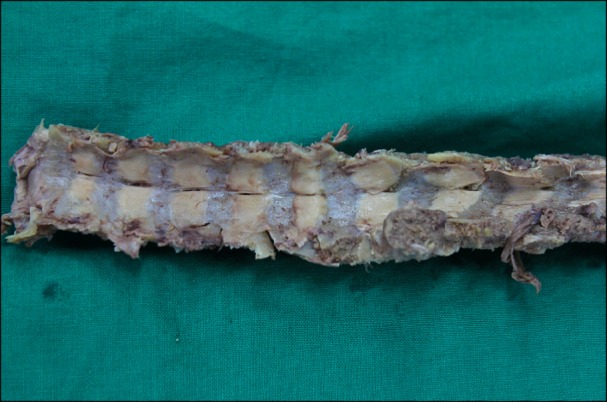Korean J Pain.
2014 Oct;27(4):321-325. 10.3344/kjp.2014.27.4.321.
Anatomic Variations of Cervical and High Thoracic Ligamentum Flavum
- Affiliations
-
- 1Department of Anatomy, Jeju National University, School of Medicine, Jeju, Korea.
- 2Department of Anesthesiology and Pain Medicine, Jeju National University, School of Medicine, Jeju, Korea. solafide5@yahoo.co.kr
- KMID: 1802497
- DOI: http://doi.org/10.3344/kjp.2014.27.4.321
Abstract
- BACKGROUND
Epidural blocks are widely used for the management of acute and chronic pain. The technique of loss of resistance is frequently adopted to determine the epidural space. A discontinuity of the ligamentum flavum may increase the risk of failure to identify the epidural space. The purpose of this study was to investigate the anatomic variations of the cervical and high thoracic ligamentum flavum in embalmed cadavers.
METHODS
Vertebral column specimens of 15 human cadavers were obtained. After vertebral arches were detached from pedicles, the dural sac and epidural connective tissue were removed. The ligamentum flavum from C3 to T6 was directly examined anteriorly.
RESULTS
The incidence of midline gaps in the ligamentum flavum was 87%-100% between C3 and T2. The incidence decreased below this level and was the lowest at T4-T5 (8%). Among the levels with a gap, the location of a gap in the caudal third of the ligamentum flavum was more frequent than in the middle or cephalic portion of the ligamentum flavum.
CONCLUSIONS
The cervical and high thoracic ligamentum flavum frequently has midline intervals with various features, especially in the caudal portion of the intervertebral space. Therefore, the ligamentum flavum is not always reliable as a perceptible barrier to identify the epidural space at these vertebral levels. Additionally, it may be more useful to insert the needle into the cephalic portion of the intervertebral space than in the caudal portion.
MeSH Terms
Figure
Cited by 1 articles
-
Guides for Pain Clinicians?
Kyung Bong Yoon
Korean J Pain. 2014;27(4):311-312. doi: 10.3344/kjp.2014.27.4.311.
Reference
-
1. Heo BH, Pyeon TH, Lee HG, Kim WM, Choi JI, Yoon MH. Epidural infusion of morphine and levobupivacaine through a subcutaneous port for cancer pain management. Korean J Pain. 2014; 27:139–144. PMID: 24748942.
Article2. Blomberg RG, Jaanivald A, Walther S. Advantages of the paramedian approach for lumbar epidural analgesia with catheter technique. A clinical comparison between midline and paramedian approaches. Anaesthesia. 1989; 44:742–746. PMID: 2478045.
Article3. Joo Y, Moon JY, Kim YC, Lee SC, Kim HY, Park SY. A pressure comparison between midline and paramedian approaches to the cervical epidural space. Pain Physician. 2014; 17:155–162. PMID: 24658476.4. Butterworth JF, Mackey DC, Wasnick JD. Spinal, epidural, & caudal blocks. Morgan & Mikhail's clinical anesthesiology. 5th ed. New York (NY): McGraw-Hill;2013. p. 953–956.5. Lirk P, Kolbitsch C, Putz G, Colvin J, Colvin HP, Lorenz I, et al. Cervical and high thoracic ligamentum flavum frequently fails to fuse in the midline. Anesthesiology. 2003; 99:1387–1390. PMID: 14639154.
Article6. Lirk P, Moriggl B, Colvin J, Keller C, Kirchmair L, Rieder J, et al. The incidence of lumbar ligamentum flavum midline gaps. Anesth Analg. 2004; 98:1178–1180. PMID: 15041621.
Article7. Kim GS. Epidural block. Korean Pain Society. Textbook of pain medicine. 4th ed. Seoul: Shin-Won Publishing;2012. p. 565–574.8. Williams A. The back. In : Standring S, editor. Gray's anatomy: the anatomical basis of clinical practice. 39th ed. Philadelphia (PA): Elsevier Churchill Livingstone;2005. p. 755.9. Moore KL, Dally AF II, Agur AM. Joints of vertebral column. Clinically oriented anatomy. 6th ed. Philadelphia (PA): Lippincott Williams & Wilkins;2010. p. 466.10. Harrison GR. Topographical anatomy of the lumbar epidural region: an in vivo study using computerized axial tomography. Br J Anaesth. 1999; 83:229–234. PMID: 10618934.
Article11. Misawa H, Ohtsuka K, Nakata K, Kinoshita H. Embryological study of the spinal ligaments in human fetuses. J Spinal Disord. 1994; 7:495–498. PMID: 7873846.
Article12. Zarzur E. Anatomic studies of the human ligamentum flavum. Anesth Analg. 1984; 63:499–502. PMID: 6711844.13. Lirk P, Colvin J, Steger B, Colvin HP, Keller C, Rieder J, et al. Incidence of lower thoracic ligamentum flavum midline gaps. Br J Anaesth. 2005; 94:852–855. PMID: 15817710.14. Hopwood D. Fixation and fixatives. In : Bancroft JD, Gamble M, editors. Theory and practice of histological techniques. 5th ed. Edinburgh: Churchill Livingstone;2002. p. 63–84.
- Full Text Links
- Actions
-
Cited
- CITED
-
- Close
- Share
- Similar articles
-
- Thoracic Myelopathy Due to Ossification of Ligamentum Flavum: Three cases Report
- Spontaneous Ligamentum Flavum Hematoma in the Rigid Thoracic Spine : A Case Report and Review of the Literature
- Cervical Radiculomyelopathy due to Calcification of the Ligamentum Flavum
- As a Cause of Myelopathy in the Lower Thracic Spines ): Two Cases Report
- Ossified Ligamentum Flavum causing Cervical Myelopathy



